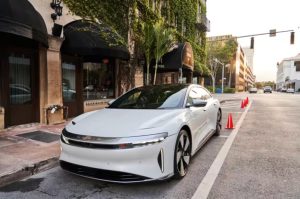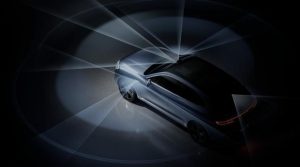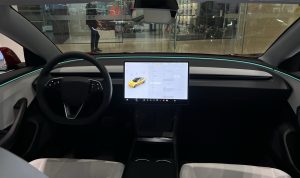Binding NVIDIA, Tengshi’s Ambitions in Autonomous Driving
7 min read
In the automotive industry, the milestone of producing 100,000 vehicles is crucial, signifying a significant achievement and entry into large-scale production. New energy vehicle manufacturers consider this milestone especially important as they navigate the electrification and automation of vehicles. Achieving such a scale also signifies market acceptance of their products and technologies, securing a favorable position in the competitive landscape.
NIO took 35 months to reach the milestone of 100,000 vehicles, XPeng needed 32 months, and Li Auto achieved it in 26 months. JinkoSolar, a solar panel manufacturer, took 18 months, and We Solutions took just 15 months. Tengshi, benefiting from its collaboration with BYD and a strong product portfolio, accomplished this goal in just one year.
On September 24th, Tengshi officially announced that its 100,000th Tengshi D9 production vehicle had rolled off the assembly line, becoming the fastest new energy luxury vehicle brand to achieve this milestone.
As a luxury MPV model, the Tengshi D9 achieved this feat in just 11 months from the first production unit. In August of this year alone, Tengshi D9 sold 10,035 units and has held the top position in sales for luxury MPVs priced over 300,000 RMB for eight consecutive months. It boasts an impressive 98% one-year resale value.
Tengshi’s robust product portfolio played a pivotal role in this achievement. On September 26th, the Tengshi N7 announced its integration with the next-generation NVIDIA DRIVE® Orin platform, enhancing its computational capabilities for faster and smarter intelligent driving.
This move also marks the beginning of the “second half of intelligence” for the Tengshi brand. While the Tengshi D9 showcased its prowess in the electrification aspect of the automotive industry, the Tengshi N7 takes on the role of the brains in the realm of intelligence.
Tengshi N7 Promotes “Intelligent Driving Equality”
Tengshi N7, a pure electric SUV, is priced between 301,800 RMB and 379,800 RMB. It is the second product launched by the Tengshi brand and enters the highly competitive market against both established and new brands, including NIO, XPeng, Li Auto, and luxury brands (BBA).
The Tengshi N7 comes equipped with BYD’s “God’s Eye” advanced intelligent driving system. According to BYD, both the domain control and algorithms of “God’s Eye” are developed in-house. In various scenarios, “God’s Eye” enables the vehicle to autonomously park and provides intelligent driver assistance, reaching a standard level 2 autonomous driving capability. By the end of 2023, Tengshi N7 will receive over-the-air updates to enable features like high-speed NOA (Navigate on Autopilot), automatic on-ramp and off-ramp, lane changes, and high-speed obstacle avoidance. In 2024, city-level NOA, as well as advanced functions like traffic light navigation, U-turns, and lane changes, will be introduced.
Tengshi’s rapid progress in autonomous driving technology through the “God’s Eye” system is a significant development. This system is now up to speed with its competitors, which include companies like We Solutions, Huawei, and Xiaopeng Motors, in implementing high-speed NOA and city-level NOA capabilities.
In terms of timing, Li Auto planned to deploy the latest version of its city-level NOA in 100 cities by the end of this year, We Solutions is set to launch its city-level intelligent driving assistance in 15 cities in the third quarter (Huawei’s AITO Wanjie M5 intelligent driving version) without relying on high-definition maps, and XPeng aims to extend its XNGP system, which does not rely on high-precision maps, to 50 cities in the second half of this year. As for BYD, it has set its sights on 2024 for the deployment of its city-level NOA, indicating that BYD is not lagging behind in terms of timeline.
Furthermore, beyond being a measure of autonomous driving capabilities, Tengshi N7 is solidifying its position through powerful hardware capabilities. The Tengshi N7 will use the Orin-N chip, introducing a new high-speed smart driving package that supports features like high-speed NOA and AVP-assisted parking. It can also communicate data with the Cloudy-A air suspension, enabling predictive road analysis.
NVIDIA’s Orin series chips have become essential for advanced intelligent driving features in luxury new energy vehicles. In the Chinese market, models including the Xiaopeng G9, Li Auto L9, L8, and L7 have all adopted the DRIVE Orin platform to enhance their assisted driving capabilities. Even autonomous driving startups like Xiao Ma Zhi Xing, Wen Yuan Zhi Xing, Lightyear Voyage, and TuSimple have begun to use this platform solution.
NVIDIA DRIVE Orin is the latest generation of NVIDIA’s intelligent automotive computing platform, with a computing power of 254 TOPS (trillions of operations per second), a sevenfold increase in computational performance compared to the previous generation Xavier system-on-chip. Since its production began last year, DRIVE Orin has been applied in various areas, including new energy passenger cars, autonomous taxis, and trucks. The scalable DRIVE Orin powers intelligent driving cabins and autonomous driving functions, relying heavily on deep neural networks to improve safety and reliability.
While Orin-N is an alternative to Orin-X, it shares the same development tools and data link capabilities. This means that automakers can use the high-level assisted driving data generated by vehicles equipped with the Orin-X chip to enhance the intelligence of vehicles equipped with the Orin-N chip during their development processes.
It’s worth noting that NVIDIA has been a leader in the field of artificial intelligence computing, particularly in areas like graphics processing (GPU), artificial intelligence (AI), high-performance computing (HPC), and autonomous driving. NVIDIA’s technologies, including the new DGX GH200 AI supercomputer and the Avatar Cloud Engine (ACE), have been recognized industry-wide. Tengshi’s collaboration with NVIDIA not only highlights the brand’s technical strength in the luxury new energy vehicle field but also accelerates the realization of intelligent driving capabilities in the Tengshi N7, especially in areas like city commuting intelligent driving assistance features.
Tengshi Gets Involved in the Intelligence Race
By partnering with NVIDIA and adopting the Orin-N chip, Tengshi fills a crucial gap in autonomous driving capabilities.
The Tengshi N7 offers three optional packages: the Tengshi Pilot Advanced Smart Driving Experience Package, the Tengshi Pilot High-Speed Smart Driving Package, and the Tengshi Pilot High-Speed Smart Driving Premium Package. The High-Speed Smart Driving Package includes the next-generation NVIDIA DRIVE Orin central chip, offering over 30 intelligent driving assistance features, including high-speed NOA, automatic parking, and remote parking via smartphone control. These features address major commuting pain points such as complex and variable conditions during high-speed cruising, mixed pedestrian and non-motorized traffic in urban areas, and inconvenient narrow parking spaces.
From a functional perspective, Tengshi, in collaboration with NVIDIA, is addressing user pain points step by step, democratizing intelligent driving, and contributing to the innovation and acceleration of global intelligent driving assistance systems.
This also means that Tengshi N
7 offers three different levels of autonomous driving capabilities, catering to the diverse needs of its customers. The standard version offers basic Level 2 autonomous driving functions, including adaptive cruise control (ACC) and lane centering control (LCC). Models equipped with the Tengshi Pilot High-Speed Smart Driving Package support high-speed NOA and can autonomously perform appropriate driving operations based on navigation information and road conditions. They also offer automatic parking and remote parking via the gear lever. Models equipped with the Tengshi Pilot High-Speed Smart Driving Premium Package can achieve various intelligent driving assistance functions, including high-speed NOA and city-level NOA, handling more complex road conditions and providing comprehensive safety assistance to drivers, significantly reducing driver fatigue and the risk of accidents.
The inclusion of dual lidar sensors and the NVIDIA Orin chip positions the Tengshi N7 to compete in the “intelligent driving race.” The advanced intelligent driving assistance system, built around the concept of “God’s Eye,” is set to introduce high-speed and city-level NOA capabilities by the end of 2023 and the first quarter of 2024, raising expectations for its performance in the field of intelligent driving.
Competing in the 300,000-400,000 RMB price range, the Tengshi N7 has strengthened its presence in all aspects. The continued success of the Tengshi D9 solidified the brand’s foundation, and the Tengshi N7 now shoulders the responsibility of expanding its territory in the realm of intelligence.
In 2022, these three brands had a combined annual sales volume of approximately 2 million vehicles. When factoring in second-tier luxury joint venture brands like Lexus, Cadillac, Volvo, as well as new energy brands like Tesla, Li Auto, NIO, and We Solutions, the total market capacity in this segment is estimated to be around 3.5 to 4 million vehicles.
More and more smart technology cars are taking the lead in this market. These products share significant features, including high-performance perception hardware, high-computing platforms, more centralized domain control architectures, and iterative logic for product experience optimization through over-the-air updates. All of these aspects have taken these cars out of the comfort zone of traditional automakers.
Apart from exceptional product capabilities, Tengshi also enjoys the advantage of being backed by BYD, giving it a strong brand endorsement. The presence of NVIDIA’s Orin chip further helps the Tengshi N7 break free from the fiercely competitive market for pure electric vehicles priced above 300,000 RMB.
According to Tengshi’s product roadmap, the brand plans to launch an executive sedan and a coupe, competing directly with the Mercedes-Benz S-Class and Porsche Panamera, respectively. Tengshi’s expertise in electric vehicle technologies, including the three-electric technology and creating a luxurious atmosphere, positions it well for this venture.
Tengshi’s rise is expected to help BYD gain a substantial market share in the 300,000 RMB and above segment. Simultaneously, the Tengshi N7, equipped with the Orin central chip, will continuously collect valuable data on intelligent driving. This will create a positive feedback loop: selling more cars, obtaining more data to enhance autonomous driving capabilities, using superior autonomous driving technology as a product advantage, and then selling more cars once again.



